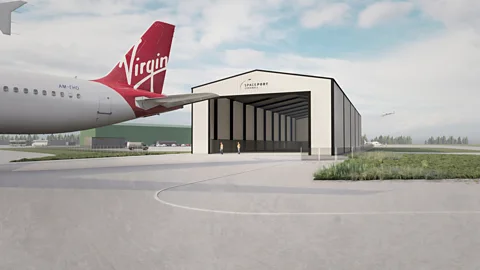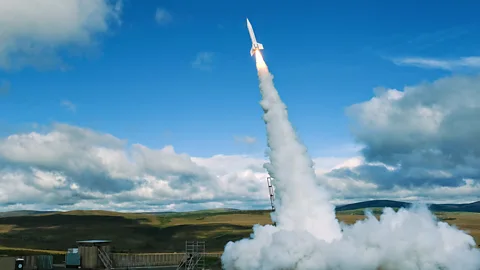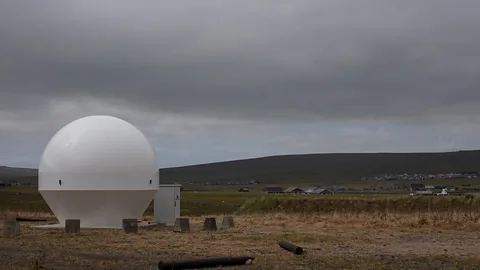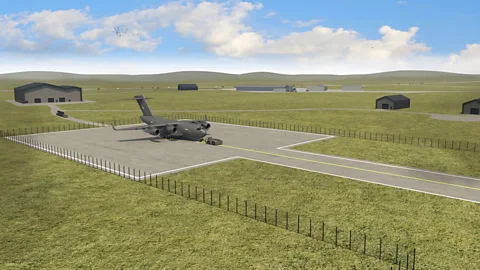Is the UK poised to return to space launches?
 Alexyz3d/Getty Images
Alexyz3d/Getty ImagesThe UK could have space launch capability as soon as this summer. What will these spaceports look like and how will they operate?
On 24 May 2021, the UK government announced that the country will develop space launch capability. A variety of sites have been selected, throughout Great Britain, with launches scheduled to commence as early as Summer 2022. These will be comparatively small launch centres though; if you're imagining something as massive as Kennedy Space Center in the US, you're on the wrong track.
This is not the first time that the UK has had space launch capability, though not necessarily within the country's own borders. In the late 1960s, the UK developed the capability to launch the Black Arrow rockets from Woomera in Australia. The project was ultimately cancelled a year later, following the Ministry of Defence's decision to use America's Scout rocket instead. "We are the only nation to build a launch capability and then scrap it after the first launch," says Melissa Thorpe, head of Spaceport Cornwall.
Initially, most satellites were launched into geostationary orbit, which stays at a fixed point above the Earth. To achieve that efficiently, it is best to launch eastwards, close to the Equator, to obtain the highest possible spin rate. "[The Earth at the Equator rotates at] about 1,400ft-per-second and in Scotland it's about 800ft-per-second,” says Scott Hammond, operations director at Shetland Space Centre. If you're at the Equator, and you want to go to geostationary, that's all free energy that throws you out."
You might also like:
Nowadays, most commercial satellites use a low Earth orbit; an altitude of 200 to 2,000km (124 to 1,240 miles). Rather than maintaining a fixed position, these satellites circle the Earth several times a day. They are typically used for Earth observation, or (if networked with other satellites) for telecommunications. Satellites in low Earth orbit can be put into a polar orbit, travelling north to south rather than west to east. To achieve a polar orbit, launching from the Equator would be an impediment, as the spin rate would need to be overcome. This makes the UK a more attractive launch site.
Spin rate is the speed an object rotates. Much like a wheel, the farther you are from the centre of axis of rotation, the faster you go. As Scotland is much closer to the North Pole than it is to the Equator, the spin rate will be lower.
 Stride Treglown/Spaceport Cornwall
Stride Treglown/Spaceport CornwallWith the privatisation of space travel, it is no longer only the preserve of resource-rich governments. In the past, massive satellites were launched by government agencies. Nowadays the technology has become much smaller, with companies like SpaceX and Virgin Orbit offering satellite launch capability. However, they still need somewhere to be launched from.
When people think of spaceports, they might think of the iconic images from the Apollo space programme, with huge rockets blasting off from the Kennedy Space Center. However, the UK's planned spaceports will be quite different. Sites throughout Great Britain will offer a variety of launch services. "We're not building Cape Canaveral,” explains Hammond. “The largest rocket is going to be about 30m (100ft) – it's a real minnow in comparison to what's flying in Cape Canaveral!"
All of these spaceports will be focused on launching small satellites into space. "Demand far outstrips supply at the moment," says Mick O'Connor, programme director for Prestwick Spaceport. "What the spaceports will do in the UK is effectively enable those small satellite companies to get their satellites into space."
The spaceports on the north coast and Shetland will offer vertical launch capability, which is where a rocket is launched vertically from the ground. This will enable polar orbit launches, with minimal risk to population centres. Spaceports on the west and south coast will offer assisted launch services, otherwise known as horizontal launches, and will be based at existing airports.
 Ian Forsyth/Getty Images
Ian Forsyth/Getty ImagesMany countries are also developing their own spaceports, but some are considering other options for their launch pads. Germany is considering using oilrigs as a platform for launching rockets, while Russia has previously launched rockets from a ship.
One of the core challenges when launching rockets from the ground is managing the jet efflux; the blast force generated by the rocket's engines. This was initially mitigated by a flame trench, which has a ramp that directs the energy away from the rocket. "That has to be very finely designed," says Hammond. "What you really don't want to happen is that the jet efflux comes down and bounces up, as then you get all kinds of issues."
Most rockets launched from the ground are now supported on a 5m (16.5ft) high metal stool, with water beneath. This allows some of the energy from jet efflux to be converted into steam as the water evaporates. "When you see the launch, what looks like smoke is actually steam," says Hammond. "It's actually a very clean burn because it's just liquid oxygen. Not only does it help suppress the sound, but it also helps protect the concrete and the metal."
Rockets are delicate instruments that need to be launched in ideal weather conditions. In addition to concerns about strong winds and rain, rockets are susceptible to atmospheric static. As rockets travel fast, they generate static electricity. Since the skin of a rocket is so thin, due to their need to be lightweight, this static can cause problems with the onboard systems, and in the worst case it can lead to an explosion.
Assisted launches, as their name implies, are carried part of the way into the atmosphere, before being launched into space. Most commonly this is by aeroplane: a rocket is carried to 10km (6.2 miles), strapped to a cradle under the wing of a Boeing 747, before being detached and launched into space. One of the benefits of assisted launches is that they negate concerns about low atmospheric wind conditions, as the rocket is launched above the cloud layer.
 SaxaVord Spaceport
SaxaVord SpaceportThese launch services will be offered from existing airports that will simply expand their facilities to incorporate space launch services into their existing operations. "With a spaceport licence, we could launch tomorrow," says Thorpe. "We're doing a few activities to futureproof the site; widening some parts of it with fillets and turn pads, just for efficiency and safety. We have one of the longest runways in the UK, at 2,744m (9,055ft) long. We are ready to go."
Another method of assisted launch is a balloon launch: a small rocket is carried some of the way through the stratosphere using high-altitude balloon. However, weight becomes a critical factor with this method.
New launch vehicles and space planes are being developed, such as the Dream Chaser. Like space shuttles, these can leave Earth orbit and return, but will need somewhere to land.
“We're looking at a technology roadmap that may allow in-orbit services from Prestwick in 2030,” says O’Connor. “You could potentially dock with the International Space Station, construct spacecraft in orbit and reach the other side of the planet in 90 minutes”
Sub-orbital flights, in which the craft reaches the edges of the atmosphere but does not enter orbit, offer the opportunity for significantly shorter flight times, as they are no longer subject to the speed constraints posed by atmospheric drag.
 Prestwick Spaceport
Prestwick Spaceport"Whilst the horizontal launch method offers significant advantages, as well as being a proven technology, the cost overheads can be a little higher, especially compared to the staggeringly low costs being offered by the like of SpaceX, with their full reusability," says Nick Howes, space research and development lead and test analyst for BMT. "The range safety and nominal orbit calculations for a moving launch platform are also not as straightforward as those for a vertical launch."
However, not everyone supports building spaceports. The Scottish Environment Protection Agency (Sepa) has raised concerns about peat management at the proposed spaceport in Unst, over concerns the peat could dry out and leach stored carbon into the atmosphere. There have also been concerns raised about the noise. However, objections against the proposed Sutherland spaceport were recently dismissed by a judge, as the challenge was not sufficiently well-founded.
Although controversial, these spaceports would act as a foundation upon which our renewed interest in space can be built, allowing the UK to once again put spacecraft into orbit.
--
If you liked this story, sign up for the weekly bbc.com features newsletter, called “The Essential List”. A handpicked selection of stories from BBC Future, Culture, Worklife, and Travel, delivered to your inbox every Friday.
